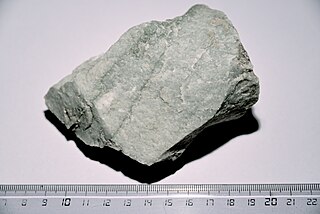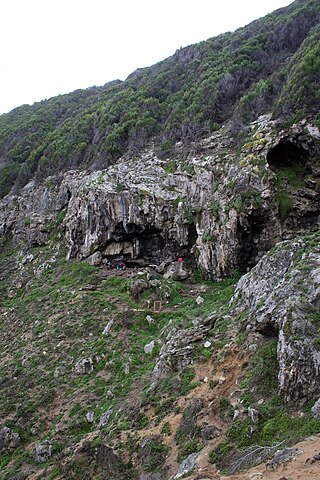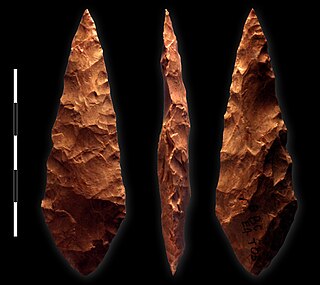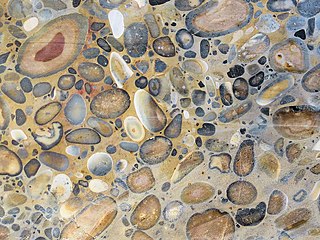
Flint, occasionally flintstone, is a sedimentary cryptocrystalline form of the mineral quartz, categorized as the variety of chert that occurs in chalk or marly limestone. Flint was widely used historically to make stone tools and start fires.

In archaeology, in particular of the Stone Age, lithic reduction is the process of fashioning stones or rocks from their natural state into tools or weapons by removing some parts. It has been intensely studied and many archaeological industries are identified almost entirely by the lithic analysis of the precise style of their tools and the chaîne opératoire of the reduction techniques they used.
A stone tool is, in the most general sense, any tool made either partially or entirely out of stone. Although stone tool-dependent societies and cultures still exist today, most stone tools are associated with prehistoric cultures that have become extinct. Archaeologists often study such prehistoric societies, and refer to the study of stone tools as lithic analysis. Ethnoarchaeology has been a valuable research field in order to further the understanding and cultural implications of stone tool use and manufacture.

In geology, rock is any naturally occurring solid mass or aggregate of minerals or mineraloid matter. It is categorized by the minerals included, its chemical composition, and the way in which it is formed. Rocks form the Earth's outer solid layer, the crust, and most of its interior, except for the liquid outer core and pockets of magma in the asthenosphere. The study of rocks involves multiple subdisciplines of geology, including petrology and mineralogy. It may be limited to rocks found on Earth, or it may include planetary geology that studies the rocks of other celestial objects.

Quartzite is a hard, non-foliated metamorphic rock which was originally pure quartz sandstone. Sandstone is converted into quartzite through heating and pressure usually related to tectonic compression within orogenic belts. Pure quartzite is usually white to grey, though quartzites often occur in various shades of pink and red due to varying amounts of hematite. Other colors, such as yellow, green, blue and orange, are due to other minerals.

Sarsen stones are silicified sandstone blocks found in quantity in Southern England on Salisbury Plain and the Marlborough Downs in Wiltshire; in Kent; and in smaller quantities in Berkshire, Essex, Oxfordshire, Dorset, and Hampshire.

Hertfordshire puddingstone is a conglomerate sedimentary rock composed of rounded flint pebbles cemented together by a younger matrix of silica quartz. The distinctive rock is largely confined to the English counties of Buckinghamshire and Hertfordshire but small amounts occur throughout the London Basin. It is quite commonly found in fields in and around Chesham, where pieces can be seen as boundary stones and in rockeries. Despite a superficial similarity to concrete, it is an entirely natural silcrete. A fracture runs across both the pebbles and the sandy matrix as both have equal strength unlike concrete where the pebbles remain whole and a fracture occurs only in the matrix. Like other puddingstones, it derives its name from the manner in which the embedded flints resemble the plums in a pudding. It forms the local base of the Upnor Formation of the Lambeth Group.

Blombos Cave is an archaeological site located in Blombos Private Nature Reserve, about 300 km east of Cape Town on the Southern Cape coastline, South Africa. The cave contains Middle Stone Age (MSA) deposits currently dated at between c. 100,000 and 70,000 years Before Present (BP), and a Late Stone Age sequence dated at between 2000 and 300 years BP. The cave site was first excavated in 1991 and field work has been conducted there on a regular basis since 1997, and is ongoing.

In archaeology, a cleaver is a type of biface stone tool of the Lower Palaeolithic.

The Roxbury Conglomerate, also informally known as Roxbury puddingstone, is a name for a rock formation that forms the bedrock underlying most of Roxbury, Massachusetts, now part of the city of Boston. The bedrock formation extends well beyond the limits of Roxbury, underlying part or all of Quincy, Canton, Milton, Dorchester, Dedham, Jamaica Plain, Brighton, Brookline, Newton, Needham, and Dover. It is named for exposures in Roxbury, Boston area. It is the Rock of the Commonwealth in Massachusetts.

The Middle Stone Age was a period of African prehistory between the Early Stone Age and the Late Stone Age. It is generally considered to have begun around 280,000 years ago and ended around 50–25,000 years ago. The beginnings of particular MSA stone tools have their origins as far back as 550–500,000 years ago and as such some researchers consider this to be the beginnings of the MSA. The MSA is often mistakenly understood to be synonymous with the Middle Paleolithic of Europe, especially due to their roughly contemporaneous time span; however, the Middle Paleolithic of Europe represents an entirely different hominin population, Homo neanderthalensis, than the MSA of Africa, which did not have Neanderthal populations. Additionally, current archaeological research in Africa has yielded much evidence to suggest that modern human behavior and cognition was beginning to develop much earlier in Africa during the MSA than it was in Europe during the Middle Paleolithic. The MSA is associated with both anatomically modern humans as well as archaic Homo sapiens, sometimes referred to as Homo helmei. Early physical evidence comes from the Gademotta Formation in Ethiopia, the Kapthurin Formation in Kenya and Kathu Pan in South Africa.

Puddingstone, also known as either pudding stone or plum-pudding stone, is a popular name applied to a conglomerate that consists of distinctly rounded pebbles whose colours contrast sharply with the colour of the finer-grained, often sandy, matrix or cement surrounding them. The rounded pebbles and the sharp contrast in colour gives this type of conglomerate the appearance of a raisin or Christmas pudding. There are different types of puddingstone, with different composition, origin, and geographical distribution. Examples of different types of puddingstones include the Hertfordshire, Schunemunk, Roxbury, and St. Joseph Island puddingstones.
The control of fire by early humans was a critical technology enabling the evolution of humans. Fire provided a source of warmth and lighting, protection from predators, a way to create more advanced hunting tools, and a method for cooking food. These cultural advances allowed human geographic dispersal, cultural innovations, and changes to diet and behavior. Additionally, creating fire allowed human activity to continue into the dark and colder hours of the evening.
The Soanian culture is a prehistoric technological culture from the Siwalik Hills in the Indian subcontinent. It is named after the Soan Valley in Pakistan. Soanian sites are found along the Siwalik region in present-day India, Nepal and Pakistan. The Soanian culture has been approximated to have taken place during the Middle Pleistocene period or the mid-Holocene epoch (Northgrippian). Debates still goes on today regarding the exact period occupied by the culture due to artefacts often being found in non-datable surface context. This culture was first discovered and named by the anthropology and archaeology team led by Helmut De Terra and Thomas Thomson Paterson. Soanian artifacts were manufactured on quartzite pebbles, cobbles, and occasionally on boulders, all derived from various fluvial sources on the Siwalik landscape. Soanian assemblages generally comprise varieties of choppers, discoids, scrapers, cores, and numerous flake type tools, all occurring in varying typo-technological frequencies at different sites.

The Niobrara Formation, also called the Niobrara Chalk, is a geologic formation in North America that was deposited between 87 and 82 million years ago during the Coniacian, Santonian, and Campanian stages of the Late Cretaceous. It is composed of two structural units, the Smoky Hill Chalk Member overlying the Fort Hays Limestone Member. The chalk formed from the accumulation of coccoliths from microorganisms living in what was once the Western Interior Seaway, an inland sea that divided the continent of North America during much of the Cretaceous. It underlies much of the Great Plains of the US and Canada. Evidence of vertebrate life is common throughout the formation and includes specimens of plesiosaurs, mosasaurs, pterosaurs, and several primitive aquatic birds. The type locality for the Niobrara Chalk is the Niobrara River in Knox County in northeastern Nebraska. The formation gives its name to the Niobrara cycle of the Western Interior Seaway.

The Ogallala Formation is a Miocene to early Pliocene geologic formation in the central High Plains of the western United States and the location of the Ogallala Aquifer. In Nebraska and South Dakota it is also classified as the Ogallala Group. Notably, it records the North American Land Mammal Ages (NALMAs) Hemphillian, Clarendonian, and Barstovian. It also includes an excellent record of grass seeds and other plant seeds, which can be used for biostratigraphic dating within the formation. The Ogallala Formation outcrops of Lake Meredith National Recreation Area preserve fish fossils. Similar specimens from the same unit are found at Alibates Flint Quarries National Monument in Texas.

The Riesenstein is a megalith or menhir, which is situated close to the village of Wolfershausen. It is the largest megalith in the district of Schwalm-Eder-Kreis, Hesse, Germany.
The Valentine Formation is a geologic unit formation or member within the Ogallala unit in northcentral Nebraska near the South Dakota border. It preserves fossils dating to the Neogene period and is particularly noted for Canid fossils. A particular feature of the Valentine is lenticular beds of green-gray opaline sandstone that can be identified in other states, including South Dakota, Nebraska, Kansas, and Colorado. Even though three mammalian fauna stages can be mapped throughout the range of the Ogallala, no beddings of the Ogallala are mappable and all attempts of formally applying the Valentine to any mappable lithology beyond the type location have been abandoned. Even so, opaline sandstone has been used to refer to the green-gray opalized conglomerate sandstone that is a particular feature of the lower Ogallala.
Church Rockshelter No.2 site situates near the Watauga River in Watauga County, North Carolina. It locates upstream from its twin site Church Rockshelter No.1 site. The No.2 site is east-southeast facing and includes two rock shelters formed by a Cranberry Gneiss outcrop. There is a lower shelter at the northern end and an upper shelter at the southern end. The site is owned by Charles Church, who discovered the site in the mid-1900s by finding many projectile points on the ground surface. A total of three excavations explored the site in the 1970s, 1975 and 2011 respectively. The site contains primarily stone and ceramic evidence from Early to Late Woodland period.

The Mlambalasi Rock Shelter is a historic site located in Iringa District of Iringa Region in southern Tanzania, 50 km away from Iringa City. Excavations in 2006 and 2010 by the Iringa Region Archaeological Project uncovered artifactual deposits from the Later Stone Age (LSA), the Iron Age, and the historic periods, as well as external artifacts from the Middle Stone Age (MSA). Direct dating on Achatina shell and ostrich eggshell beads indicates that the oldest human burials at Mlambalasi are from the terminal Pleistocene. Mlambalasi is characterized by interment LSA and Iron Age periods, as well as by cycles of use and abandonment.
















